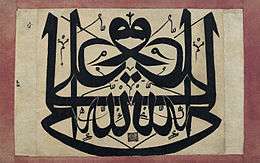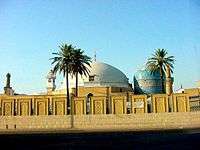Qalandariyya
| Part of a series on |
| Islam |
|---|
 |
|
Related topics |
|
| |
|---|
 |
|
|
The Qalandariyyah (Arabic: قلندرية, Hindi: क़लन्दरिय्या, Bengali: ক়লন্দরিয়্য়া), Qalandaris or Kalandars are wandering Sufi dervishes. The term covers a variety of sects, not centrally organized. One was founded by Qalandar Yusuf al-Andalusi of Andalusia, Spain.
Starting in the early 12th century, the movement gained popularity in Greater Khorasan and neighbouring regions, including the South Asia.[1] The first references are found in the 11th-century prose text Qalandarname (The Tale of the Kalandar) attributed to Ansarī Harawī. The term Qalandariyyat (the Qalandar condition) appears to be first applied by Sanai Ghaznavi (died 1131) in seminal poetic works where diverse practices are described. Particular to the qalandar genre of poetry are terms that refer to gambling, games, intoxicants and Nazar ila'l-murd, themes commonly referred to as kufriyyat or kharabat. The genre was further developed by poets such as Fakhr-al-Din Iraqi and Farid al-Din Attar.
Qalandariyya in South Asia
The Qalandariya may have arisen from the earlier Malamatiyya and exhibited some Buddhist and Hindu influences in South Asia.[2] The Malamatiya condemned the use of drugs and dressed only in blankets or in hip-length hairshirts.[3]
The writings of qalandars were not a mere celebration of libertinism, but antinomial practices of affirmation from negative action. The order was often viewed suspiciously by authorities.
The term remains in popular culture. Sufi qawwali singers the Sabri brothers and international Qawwali star Nusrat Fateh Ali Khan favoured the chant dam a dam masta qalandar (with every breath ecstatic Qalandar!), and a similar refrain appeared in a hit song from Runa Laila from movie Ek Se Badhkar Ek that became a dancefloor crossover hit in the 1970s.
In Pakistan and North India, descendents of Qalandariyah faqirs now form a distinct community, known as the Qalandar biradari.
See also
| |||
|---|---|---|---|
| The Fourteen Infallibles | |||
|
|||
| Principles | |||
| Other beliefs | |||
| Practices | |||
| Holy cities | |||
| Groups | |||
|
|
|||
| Scholarship | |||
| Hadith collections | |||
| Related topics | |||
| Related portals | |||
|
|||
- Ashurkhana
- Jamatkhana
- Imambargah
- Khalwatkhana
- Khanaqa
- Mejlis
- Musallah
- Hussainia
- Tekkes
- Malamatiyya
- Mawlawiyyah
- Hurufiyya
- Rifa'iyya
- Qadiriyya
- Galibi Order
- Bektashiyyah
- Naqshbandiyyah
- Zahediyya
- Khalwatiyya
- Bayramiyya
- Safaviyya
- Qalandar
Bibliography
- De Bruijn, The Qalandariyyat in Persian Mystical Poetry from Sana'i, in The Heritage of Sufism, 2003.
- Ashk Dahlén, The Holy Fool in Medieval Islam: The Qalandariyat of Fakhr al-din Araqi, Orientalia Suecana, vol.52, 2004.
References
- ↑ "Merriam-Webster's Encyclopædia of World Religions". Merriam-Webster. 1999. Retrieved 22 October 2011.
The movement is first mentioned in Khorasan in the 11th century; from there it spread to India, Syria, and western Iran.
- ↑ "Merriam-Webster's Encyclopædia of World Religions". Merriam-Webster. 1999. Retrieved 22 October 2011.
The Qalandariya seem to have arisen from the earlier MALAMATIYA in Central Asia and exhibited Buddhist and perhaps Hindu influences.
- ↑ "Merriam-Webster's Encyclopædia of World Religions". Merriam-Webster. 1999. Retrieved 22 October 2011.
The Qalandariya seem to have arisen from the earlier MALAMATIYA in Central Asia and exhibited Buddhist and perhaps Hindu influences.
